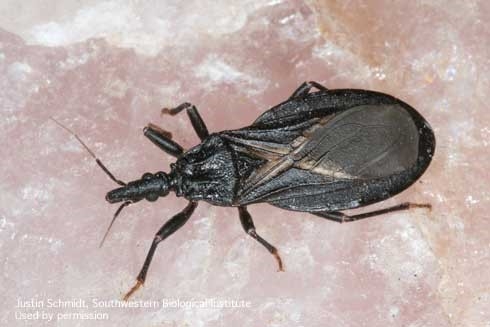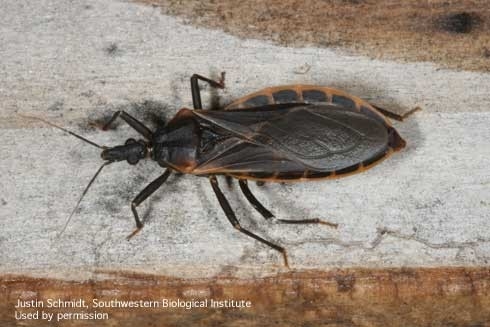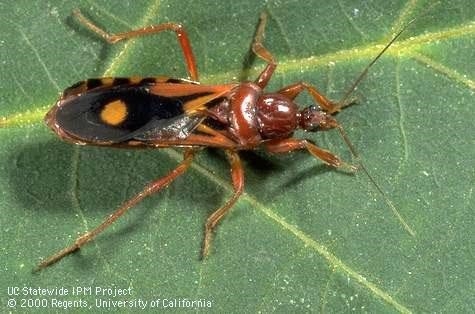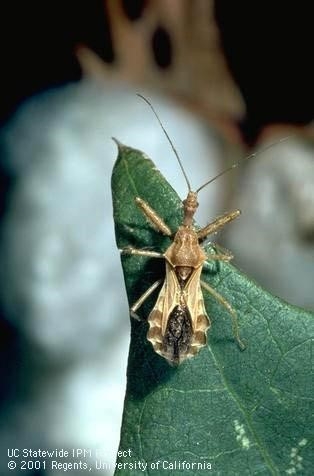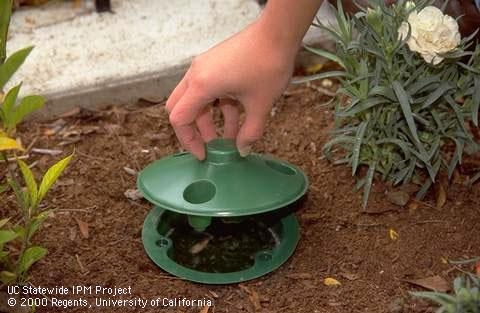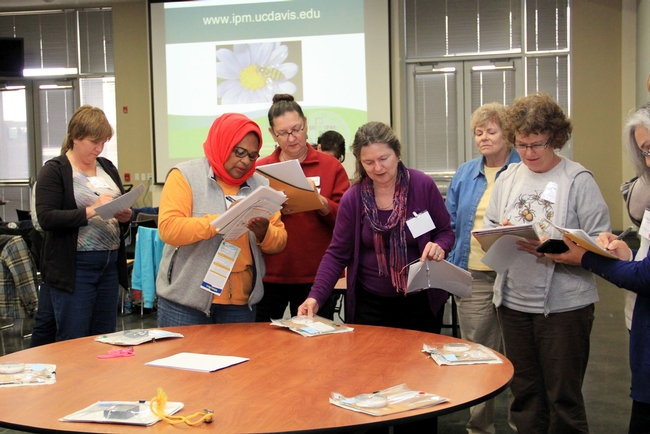Posts Tagged: UC IPM
Conenose or ‘kissing bugs’
UC IPM Pest Note Available
In anticipation of questions, we recommend UC Master Gardener volunteers read and bookmark the UC IPM Pests Notes: Conenose Bugs.
As indicated by UC IPM, there is a low instance of Chagas disease in humans in the U.S. “Researchers attribute the low incidence of Chagas disease…to poor efficacy of disease transmission by the bugs, infrequent human contact, and inability of the bugs to permanently colonize homes.”
Conenose bugs are in the Reduviidae family, a group of insects known for a sturdy body and large proboscis. Most reduviids are beneficial as insect predators, and include various species of assassin bugs. Conenose bugs are easily confused with other assassin bugs as well as bugs with similar body shapes from other insect families. Conenose bugs prefer sheltered habitat such as indoors, beneath porches, in wood or brush piles, and in outdoor structures such as dog houses and chicken coops.
ID Methods and Resources
If you receive a call about conenose bugs in your area, alert the caller not to touch the bug with bare hands. They can bring a sample in a sealed container or take a picture and send it to their local UC Master Gardener Program, UCCE advisor, or county agricultural commissioner for identification. Information that can be sent to the client include the UC IPM Pest Note on conenose bugs as well as information available on the Centers for Disease Control and Prevention website. The CDC web site also has useful photos to help in identification.
The insects below are NOT kissing bugs:
Snails, Slugs, and Spiders Star in New Videos from UC IPM
Do you have snails and slugs chewing up your favorite garden plants? Are spiders hanging out in and around your home? How can you get rid of those pesky webs?
The UC Statewide IPM program has just released six short videos to help you find answers to these questions. Find the videos on the UC IPM YouTube channel or linked from the specific Pest Notes publications on Snails and Slugs or Spiders.
Snails and slugs chew holes in leaves and fruit of many different types of plants, but they aren’t always present when the damage is discovered. Caterpillars, earwigs, grasshoppers, weevils, and others cause similar damage. How can you identify the culprit? The short video clip “Did a snail eat my plant?” shows damage caused by various pests and can help you identify snail or slug damage by looking for their characteristic slime trails and excrement.
If you do have snails and slugs in the garden and want to control them without using pesticides, learn how to combine trapping with other nonchemical methods for best results in the clip “Trapping snails and slugs.” If you decide to use a pesticide, check out the video on ”How to apply snail and slug bait.” You’ll learn what types of baits are best, which ones to avoid, and how and when to apply them for best results.
Although many people fear them, most spiders you encounter during the day are harmless and can be beneficial in your garden and landscape by eating pest insects.. You can see different kinds of spiders in the short clip “Common garden spiders.” However beneficial they may be, you might not want them inside your home. Even though the easiest method of getting rid of a spider is to kill it, why not trap it and let it loose outdoors to eat those garden pests? “How to catch a spider” shows several ways to easily trap a spider and let it go, including two types of nifty spider catchers that catch spiders in hard-to-reach places. Now what about those sticky webs? “How to clean up spider webs” shows practical methods for removing webs from around your home such as vacuuming, sealing holes in cracks or screens, hosing them off, or using a Webster tool. These methods can also help to keep spiders out of your home.
For more information on snails, slugs, spiders, and other home and garden pests, visit the UC IPM web site.
Happy New (Program) Year!
Happy New Year! I’m sure I’m not the first to welcome you to a new program year for Master Gardener programs statewide, but am I am pleased to share with you some exciting news from this past year now that the dust of recertification has settled. Program Year 2012-1013 was a busy one for California Master Gardeners, as I’m sure you’ll see for yourself from the numbers below! Last July 1st marked the first time all 45 Master Gardener programs recertified at the same time of the year, and since then we’ve been going like gang busters! Just check out some of the amazing things that UC Master Gardeners did in the last year!
Program rosters now tell us that statewide we have 5,404 volunteers who dedicate themselves to extending UC research-based home horticulture information to the public. Programs range in size from fourteen to over three hundred Master Gardeners, but the thing they all have in common is their passion for horticulture and the desire to not only learn more, but share what they learn with other Californians. From July 1, 2012-June 30, 2013 UC MGs donated over 348,132 volunteer hours to their respective communities. If we want to think about this monetarily (and who doesn’t?!), the value of this time to UC ANR comes in at over $8.6 million!* Another way to think of it, is to compare these hours to current resources UCCE has at its disposal. As of this last year the University of California Cooperative Extension had 171 advisors listed in the directory that were categorized as specializing in “Plant Commodities or Products” –only forty of which specialized in “Ornamental Plants, Landscape, and Turf”. When we compare the staggering number of volunteer hours, we find that this figure equates to approximately 180 full time employees** for the University of California. In effect, with the Master Gardener program in place, we more than double our “staff” available to answer plant and pest-related queries from the public and provide that invaluable arm of extension by connecting California residents with UC research.
Volunteering for their communities is not the only way UC Master Gardeners spend their time, however. Last year over 76,480 hours were logged in continuing education as Master Gardeners worked to keep themselves informed about new or advanced horticultural topics and trends. In addition to presentations and workshops presented at the local program level, the Statewide Master Gardener Program hosted six 2-day regional trainings on Edible Landscaping and four regional workshops on Advanced Citrus and Avocado Care (including special focus on new citrus threat, Asian Citrus Psyllid). The Statewide UC IPM program also hosted opportunities for Master Gardeners to expand their knowledge of home and garden pests and treatment options via three regional Advanced IPM trainings.
The volunteers aren’t the only ones putting in the hours, though! The Statewide Master Gardener Program has also been hard at work this year working to support and provide developmental opportunities for the 45 Master Gardener programs around the state. One of the most exciting ways we were able to offer support in the last year and moving forward was a grant opportunity for programs to seek partial or full funding for a Program Representative (local MG coordinator) position starting July 1, 2013 and continuing through June of 2015. Many applications were submitted and in total the grant funded 19 county-based positions, including one brand new program that will take shape in the Lassen, Sierra, and Plumas counties. In order to aid programs in continued development, the Statewide Master Gardener Program also hosted 13 webinars and a two-day training for Program Coordinators, ranging in topics from best practices for Social Media to Volunteer Recognition. In November 2012 the Statewide Program also hosted the first ever Volunteer Leadership Summit, in which we invited each program to send a Master Gardener volunteer who was directly involved with the leadership of the local program to attend a day-long training on Middle Management topics and provide an opportunity for networking across counties.
It certainly has been a year of many triumphs for the UC Master Gardener Program. Thank you for the time and effort that you put into this program. We are continually astounded by the work that is accomplished by California Master Gardeners and feel extremely lucky to work with such talented and selfless individuals. We look forward to another incredibly successful year and can’t wait to chart the leaps and bounds we are sure to take statewide this year!
*Value of volunteer time found by using Independent Sector estimate of $24.75/hour in California. Find current rate at: http://www.independentsector.org/programs/research/volunteer_time.html
** assumes 1928 working hours per year.
Bed Bug Monitors Enable Early Detection
Bed bugs are quickly becoming major household nuisance pests. California has recently experienced a multitude of bed bug reports, with San Francisco now considered one of the Top 10 most infested cities in the country. Bed bug detection can be very difficult and almost always requires special training since bugs prefer to hide in dark, inaccessible cracks and crevices near their hosts’ resting spots. An experienced pest management professional can examine all possible harborages in a home, searching for the bugs themselves and signs of infestation such as the characteristic black fecal spotting and cast nymphal skins, although low-density infestations may escape detection.
Thankfully, several monitors are available that attract or intercept bed bugs. Bed bug monitors fall within one of two categories: active monitors and passive monitors. Active monitors employ attractants—heat, carbon dioxide, host odors (kairomones), pheromones, or a combination of these—to lure bed bugs out of their hiding areas and into a pitfall or sticky trap within the monitor. These devices have the potential to detect bed bugs in the absence of a host (vacant room). Passive monitors either exploit a bed bug’s affinity for dark crevices or rely on chance encounters with pitfalls or sticky traps. Interceptor monitors are pitfall devices that rely on the presence of a host (a sleeping human) to attract hungry bugs and trap them en route to their meal.
A team of UC researchers led by UC Berkeley entomologist Vernard Lewis recently evaluated a series of five bed bug monitors. Overall the study concluded that active monitors recovered a steady proportion of bed bugs as densities increased and that all monitors tested were able to detect bed bugs at low densities.
Read more in the February 2013 issue of the UC IPM Green Bulletin. More information on bed bug biology and management is available in the just revised Pest Note: Bed Bugs on the UC IPM web site.





